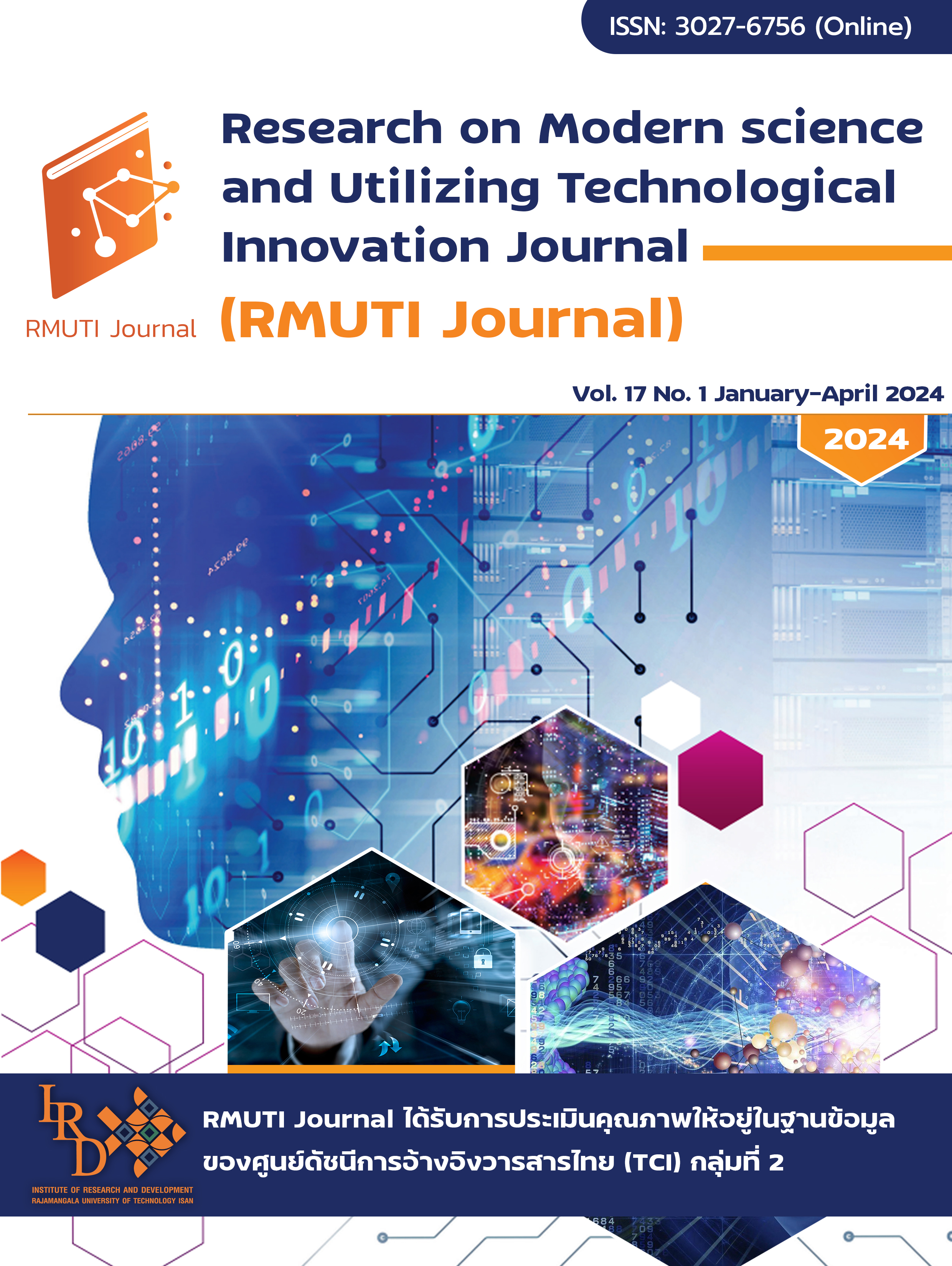การศึกษาสมบัติเชิงกลและสัณฐานวิทยาของพอลิโพรพิลีนที่ผสมผงยาง อีพีดีเอ็มจากซีลประตูรถยนต์
Main Article Content
บทคัดย่อ
งานวิจัยนี้ทำการศึกษาสมบัติเชิงกลและสัณฐานวิทยาของพอลิโพรพิลีนที่ผสมผงยางอีพีดีเอ็มจากซีลประตูรถยนต์ซึ่งผงยางอีพีดีเอ็มทำการเตรียมทั้งแบบไม่ดีวัลคาไนซ์และดีวัลคาไนซ์ด้วยวิธีการใช้ความร้อนร่วมกับแรงทางกลโดยศึกษาการดีวัลคาไนซ์ยางอีพีดีเอ็มในขั้นตอนการบดด้วยเครื่องบดแบบสองลูกกลิ้งที่อุณหภูมิ 220 และ 230 oC ความเร็วรอบลูกกลิ้ง 40 รอบต่อนาที เป็นเวลา 25 นาที จากนั้นบดต่อในเครื่องผสมภายในที่อุณหภูมิ 200 oC ความเร็วรอบโรเตอร์ 140 รอบต่อนาที เป็นเวลา 10 นาที แล้วนำไปตรวจสอบความสามารถในการดีวัลคาไนซ์ของยางจากวิธีการสกัดด้วยซอกเลต เพื่อเลือกอุณหภูมิที่เหมาะสม โดยนำผงยางอีพีดีเอ็มทั้งสองแบบผสมลงในพอลิโพรพิลีนที่อัตราส่วน 0/100 10/90 20/80 30/70 และ 40/60 เปอร์เซ็นต์โดยนํ้าหนัก ด้วยเครื่องผสมภายในแล้วขึ้นรูปแผ่นจากเครื่องอัดร้อน และนำไปทดสอบสมบัติการรับแรงดึงและแรงกระแทก รวมถึงตรวจสอบลักษณะทางสัณฐานวิทยาพบว่า การดีวัลคาไนซ์ในขั้นตอนการบดด้วยเครื่องบดแบบสองลูกกลิ้งที่อุณหภูมิ 230 oC มีเปอร์เซ็นต์ของยางส่วนที่ละลายสูงกว่าที่อุณหภูมิ 220 oC ซึ่งแสดงถึงสามารถในการดีวัลคาไนซ์ดีกว่าโดยพอลิโพรพิลีนที่ผสมผงยางอีพีดีเอ็มทั้งสองแบบในปริมาณที่มากขึ้นส่งผลให้ค่ายังมอดุลัสลดลง แต่ความยืดสูงสุด ณ จุดขาด และความทนแรงกระแทกเพิ่มสูงขึ้น ส่วนความต้านแรงดึงเริ่มมีแนวโน้มลดลงเมื่อผสมผงยางอีพีดีเอ็มแบบไม่ดีวัลคาไนซ์และแบบดีวัลคาไนซ์ที่ปริมาณ 30 และ 40 เปอร์เซ็นต์โดยนํ้าหนัก ซึ่งการผสมผงยางอีพีดีเอ็มแบบดีวัลคาไนซ์ลงในพอลิโพรพิลีนให้สมบัติเชิงกลค่อนข้างดีกว่าผงยางแบบไม่ดีวัลคาไนซ์ เนื่องจากผงยางอีพีดีเอ็มแบบดีวัลคาไนซ์ถูกทำให้มีขนาดเล็กลงและกระจายตัวได้ดี ส่งผลให้มีพื้นที่ผิวยึดเกาะกับเมทริกซ์พอลิโพรพิลีนมากขึ้น อีกทั้งผงยางแบบดีวัลคาไนซ์ถูกตัดขาดการเชื่อมขวางทำให้สายโซ่โมเลกุลเคลื่อนที่ได้อิสระและสามารถเข้ากันได้กับพอลิโพรพิลีนได้มากขึ้น
Article Details

อนุญาตภายใต้เงื่อนไข Creative Commons Attribution-NonCommercial-NoDerivatives 4.0 International License.
เอกสารอ้างอิง
Erman, B., Mark, J. E., and Roland, C. M. (2013). The Science and Technology of Rubber. 4th eds. Amsterdam: Elsevier
German, R. (1999). Non-Tyre Rubber Components in the Automotive Industry. Shrewsbury: iSmithers Rapra Publishing
Dorigato, A., Rigotti, D., and Fredi, G. (2022). Recent Advances in the Devulcanization Technologies of Industrially Relevant Sulfur-Vulcanized Elastomers. Advanced Industrial and Engineering Polymer Research. Vol. 6, Issue 3, pp. 288-309. DOI: 10.1016/j.aiepr.2022.11.003
Simon, D. Á. and Bárány, T. (2023). Microwave Devulcanization of Ground Tire Rubber and Its Improved Utilization in Natural Rubber Compounds. ACS Sustainable Chemistry & Engineering. Vol. 11, No. 5, pp. 1797-1808. DOI: 10.1021/acssuschemeng.2c05984
Movahed, S. O., Ansarifar, A., Karbalaee, S., and Far, S. A. (2015). Devulcanization and Recycling of Waste Automotive EPDM Rubber Powder by Using Shearing Action and Chemical Additive. Progress in Rubber, Plastics and Recycling Technology. Vol. 31, Issue 2, pp. 87-116. DOI: 10.1177/147776061503100202
Rigotti, D., Dorigato, A., Valentini, F., and Pegoretti, A. (2023). Devulcanization Parameters and Mechanical Properties of EPDM/Ground Tire Rubber Compounds. Rubber Chemistry and Technology. Vol. 96, Issue 1, pp. 114-129. DOI: 10.5254/rct.23.77949
Simon, D. Á . and Bá rá ny, T. (2021). Effective Thermomechanical Devulcanization of Ground Tire Rubber with a Co-rotating Twin-Screw Extruder. Polymer Degradation and Stability. Vol. 190, Article 109626. DOI: 10.1016/j.polymdegradstab.2021.109626
Colom, X., Carrillo-Navarrete, F., Saeb, M. R., Marin, M., Formela, K., and Cañavate, J. (2023). Evaluation and Rationale of the Performance of Several Elastomeric Composites Incorporating Devulcanized EPDM. Polymer Testing. Vol. 121, Article 107976. DOI: 10.1016/j.polymertesting.2023.107976
Sripornsawat, B., Saiwari, S., and Nakason, C. (2018). Thermoplastic Vulcanizates Based on Waste Truck Tire Rubber and Copolyester Blends Reinforced with Carbon Black. Waste Management. Vol. 79, pp. 638-646. DOI: 10.1016/j.wasman.2018.08.038
Simon, D. Á., Halász, I. Z., Karger-Kocsis, J., and Bárány, T. (2018). Microwave Devulcanized Crumb Rubbers in Polypropylene Based Thermoplastic Dynamic Vulcanizates. Polymers. Vol. 10, Article 767. DOI: 10.3390/polym10070767
de Sousa, F. D. B., Gouveia, J. R., de Camargo Filho, P. M. F., Vidotti, S. E., Scuracchio, C. H., Amurin, L. G., and Valera, T. S. (2015). Blends of Ground Tire Rubber Devulcanized by Microwaves/HDPE - Part A: Influence of Devulcanization Process. Polímeros. Vol. 25, No. 3, pp. 256-264. DOI: 10.1590/0104-1428.1747
Pirityi, D. Z. and Pölöskei, K. (2021). Thermomechanical Devulcanization of Ethylene Propylene Diene Monomer Rubber and Its Application in Blends with High-Density Polyethylene. Journal of Applied Polymer Science. Vol. 138, Issue 13, Article 50090. DOI: 10.1002/app.50090
Dong, H., Zhong, J., and Isayev, A. I. (2021). Manufacturing Polypropylene (PP)/Waste EPDM Thermoplastic Elastomers Using Ultrasonically Aided Twin-Screw Extrusion. Polymers. Vol. 13, Issue 2, Article 259. DOI: 10.3390/polym13020259
Garcia, P. S., de Sousa, F. D. B., de Lima, J. A., Cruz, S. A., and Scuracchio, C. H. (2015). Devulcanization of Ground Tire Rubber: Physical and Chemical Changes after Different Microwave Exposure Times. eXPRESS Polymer Letters. Vol. 9, No. 11, pp. 1015-1026. DOI: 10.3144/expresspolymlett.2015.91
Görbe, Á., Kohári, A., and Bárány, T. (2024). Efficiency of Thermomechanical Reclaiming of Ground Tire Rubber Conducted in Counter-rotating and Co-rotating Twin Screw Extruder. Polymers. Vol. 59, Issue 3, Article 455. DOI: 10.14314/polimery.2014.231
Brunella, V., Aresti, V., Romagnolli, U., Muscato, B., Girotto, M., Rizzi, P., and Luda, M. P. (2022). Recycling of EPDM via Continuous Thermo-Mechanical Devulcanization with Co-Rotating Twin-Screw Extruder. Polymers. Vol. 14, Issue 22, Article 4853. DOI: 10.3390/polym14224853
Diaz, R., Colomines, G., Peuvrel-Disdier, E., and Deterre, R. (2018). Thermo-Mechanical Recycling of Rubber: Relationship Between Material Properties and Specific Mechanical Energy. Journal of Materials Processing Technology. Vol. 252, pp. 454-468. DOI: 10.1016/j.jmatprotec.2017.10.014
Simon, D. Á., Pirityi, D. Z., and Bárány, T. (2020). Devulcanization of Ground Tire Rubber: Microwave and Thermomechanical Approaches. Scientific Reports. Vol. 10, Article 16587. DOI: 10.1038/s41598-020-73543-w
Zulkifli, M. H., Rasidi, M. S. M., Musa, L., and Masa, A. H. (2021). The Study of Recycled Ethylene Propylene Diene Monomer (EPDM-r)/Polypropylene (PP) Polymeric Blends. Journal of Physics: Conference Series. Vol. 2080, Article 012012. DOI: 10.1088/1742-6596/2080/1/012012
Song, L. F., Bai, N., Shi, Y., Wang, Y. X., Song, L. X., and Liu, L. Z. (2023). Effects of EthylenePropylene-Diene Monomers (EPDMs) with Different Moony Viscosity on Crystallization Behavior, Structure, and Mechanical Properties of Thermoplastic Vulcanizates (TPVs). Polymers. Vol. 15, Issue 3, Article 642. DOI: 10.3390/polym15030642
Lendvai, L. (2023). Mechanical and Morphological Properties of PP/XNBR Blends Produced with Rubber Latex. Journal of Polymer Research. Vol. 30, Article 276. DOI: 10.1007/s10965-023-03660-3
Ridhwan, M., Nasir, J., Zulkepli, N. N., Mustafa, M., Abdullah, M. M. A. B., Omar, M. F., Ismail, H., and Sandu, A. V. (2014). The Effects of Different Particle Sizes of Recycled Acrylonitrile Butadiene Rubber and its Blend Ratios on Mechanical and Morphological Properties of vNBR/rNBR Blends. Materiale Plastice. Vol. 51, No.2, pp. 201-204
Ujianto, O., Putri, D. B., and AWinarto, D. (2017). A Comparative Study of Ground Tire Rubber Devulcanization using Twin Screw Extruder and Internal Mixer. IOP Conference Series: Materials Science and Engineering. Vol. 223, Article 012005. DOI: 10.1088/1757-899X/223/1/012005


